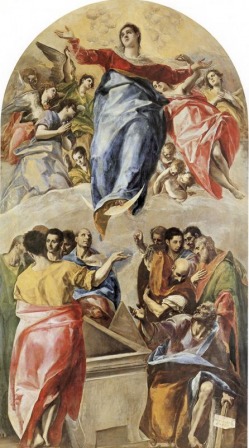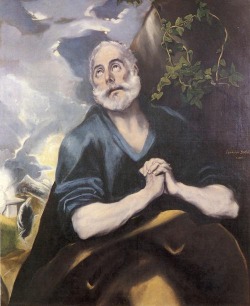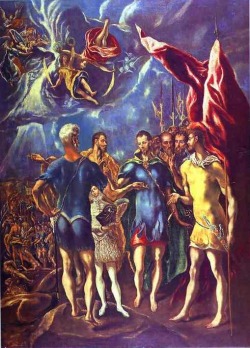El Greco (Domenikos Theotokopoulos)
Biography
El Greco was born in Crete in 1541 AD. His birth name was Domenikos Theotokopoulos. He had a Greek heritage, and that is where the name El Greco came from. El Greco means “The Greek”. Little is known about his childhood, but it is known that he moved to Venice around the year 1566. In Venice, El Greco worked near Titian and Tintoretto. He was inspired by the way they used color and space in their art. One picture that can show his use of space and color is “Christ healing the Blind Man”.
Around the year 1570, he moved to Rome, where he was greatly influenced by Michelangelo, and Roman Architecture. Two paintings from his time in Rome are “Pietà”, and “Purification of the Temple”. He then moved back to Spain, where he painted the “Assumption of the Virgin”. Since he moved to Spain, he began using colors in interesting ways, and interesting ways of showing the proportions of the figures. He painted “The Burial of Count Orgaz” in Toledo in the year of 1586. It includes a lot of figures, to cover up any empty space that might have been visible, which is called “Horror Vacui” as well as interesting proportions of the humans. Those properties of his art show that he stuck to the style of “Mannerism”, even after it was not popular at that time. Most paintings by El Greco show how spiritual he was. He died in 1614, and all his paintings until his death showed how spiritual he was with the style in which he painted.
Around the year 1570, he moved to Rome, where he was greatly influenced by Michelangelo, and Roman Architecture. Two paintings from his time in Rome are “Pietà”, and “Purification of the Temple”. He then moved back to Spain, where he painted the “Assumption of the Virgin”. Since he moved to Spain, he began using colors in interesting ways, and interesting ways of showing the proportions of the figures. He painted “The Burial of Count Orgaz” in Toledo in the year of 1586. It includes a lot of figures, to cover up any empty space that might have been visible, which is called “Horror Vacui” as well as interesting proportions of the humans. Those properties of his art show that he stuck to the style of “Mannerism”, even after it was not popular at that time. Most paintings by El Greco show how spiritual he was. He died in 1614, and all his paintings until his death showed how spiritual he was with the style in which he painted.
Assumption of the Virgin

This painting was painted on canvas with oil paint. It shows Mary being brought into heaven when she died. In some religions, she is believed to have been taken into heaven body and soul, so this picture shows how El Greco imagined the scene happening, as if he was there.
St. Peter in Tears

This painting was also painted with oil paints on canvas. Saint peter appears sad in this picture, most likely because Jesus, whom he believed to be Christ, has died. Saint Peter was originally named Simon, then Jesus had his name changed to Peter. Look at how this painting has a little bit less detail than The Assumption of the Virgin, but is still very realistic.
The Martyrdom of St. Maurice

This painting was also done with oil paint on canvas, in around 1580. It shows the Massacre of St. Maurice, who is usually considered the patron saint of warriors and soldiers. The colors in this painting are darker, Probably to show how solemn and dark the mood of the event really was, when it happened.
